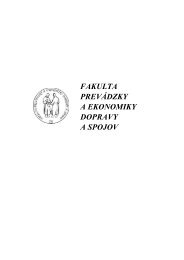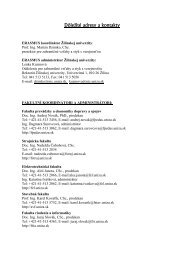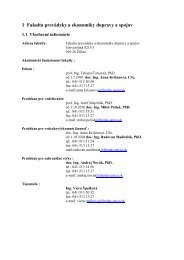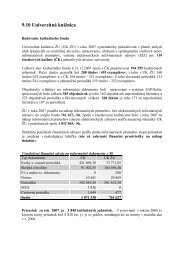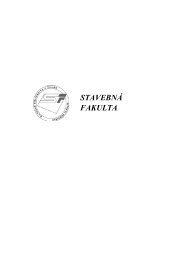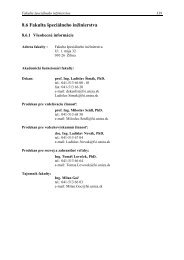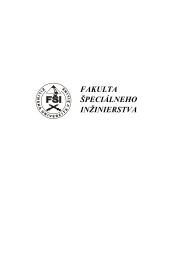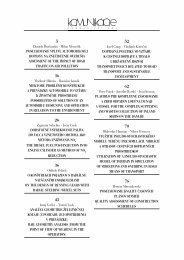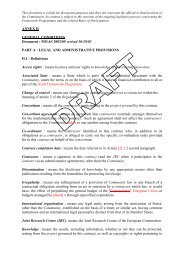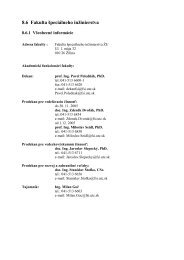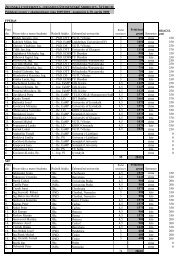n - Žilinská univerzita
n - Žilinská univerzita
n - Žilinská univerzita
Create successful ePaper yourself
Turn your PDF publications into a flip-book with our unique Google optimized e-Paper software.
C O M M U N I C A T I O N S<br />
I S<br />
●<br />
●<br />
●<br />
verejné inštitúcie, zabezpečujúce organizáciu a koordináciu dopravných,<br />
poštových a telekomunikačných služieb v regióne –<br />
ich úlohou je zabezpečiť kvalitu služieb z hľadiska uspokojenia<br />
očakávaní zákazníka. K tomu patrí vytvorenie stratégie kvality,<br />
využívanie vhodných technológií, skúmanie očakávaní zákazníkov,<br />
monitoring a sledovanie výkonov, sledovanie spokojnosti zákazníkov,<br />
vyhodnocovanie efektívnosti poskytovania služieb;<br />
poskytovatelia služieb – efektívne využívanie zdrojov, sledovanie<br />
kvality výstupu. Ich úlohou je výkon služieb a plnenie plánovaných<br />
úloh a funkcií;<br />
zákazníci – občania, podniky, ktoré v rôznej miere využívajú<br />
služby pre uspokojenie svojich potrieb prepraviť osoby, správy<br />
a náklad.<br />
Kritériá kvality musia rešpektovať predovšetkým tie charakteristiky<br />
služby, ktoré sú rozhodujúce pre všetkých účastníkov služby,<br />
ale predovšetkým pre zákazníka. Kritériá kvality je možné odvodiť<br />
z rôznych zdrojov blízko zákazníka – môže ich definovať poskytovateľ<br />
služby napr. na základe skúmania sťažností a reakcií zákazníkov<br />
a odsúhlasí ich so zákazníkmi (priradením dôležitosti kritérií).<br />
Jestvuje množstvo odborných názorov a odporúčaní, ktoré sa zameriavajú<br />
na určenie kritérií kvality v službách všeobecne i jednotlivo<br />
pre kritériá kvality služieb dopravy, pôšt a telekomunikácií. V tabuľke<br />
č. 1. je uvedený prehľad kritérií (resp. ich skupín), pričom boli<br />
použité:<br />
– pre všeobecný pohľad na služby – kritériá (dimenzie služby),<br />
navrhnuté podľa [7];<br />
– pre oblasť dopravy sú určujúce odporúčania CEN (Comitée<br />
europeéne de normalisation), ktoré pre definovanie úrovne kvality<br />
odporúčajú v technickej norme TC 320 pre kvalitu služieb verejnej<br />
hromadnej dopravy;<br />
– pre oblasť telekomunikačných služieb odporúčania ITU E.800.<br />
– pre oblasť poštových služieb – závery 22. Svetového poštového<br />
kongresu (Peking 1999), kde sa schválilo vytvorenie základných<br />
kritérií kvality (Quality of Service Fund – QFS) [8].<br />
Kritériá sú v tabuľke č. 1 usporiadané tak, aby poukazovali na<br />
príbuznosť jednotlivých návrhov. Pri predstavenom usporiadaní<br />
kritérií sú na prvý pohľad zjavné rozdiely i spoločné prvky.<br />
Úplná zhoda je v kritériu „dostupnosť“, ktoré je orientované<br />
na splnenie základnej požiadavky zákazníkov [9] – minimálny odpor<br />
pre dosiahnutie bodu poskytnutia služby. To dokazuje jeho výnimočné<br />
postavenie v oblasti služieb všeobecne i pre oblasť služieb<br />
dopravy, pôšt a telekomunikácií. Podobne je to s bezpečnosťou<br />
a spoľahlivosťou, ktoré sa vzťahujú na prepravovaný objekt, resp. na<br />
technickú podporu – schopnosť nepretržitého (bezporuchového)<br />
poskytovania služby.<br />
Jeden z výrazných rozdielov tvorí skutočnosť, že medzi kritériami<br />
pre sektor služieb všeobecne sa vyskytuje kritérium „materializácia<br />
služby“, ktoré nemá explicitne „partnera“ v ďalších stĺpcoch<br />
tabuľky. Je to spôsobené tým, že produkt sektoru služieb vo všeobecnosti<br />
má nemateriálnu povahu, preto je potrebné ho materializovať,<br />
aby ho zákazník lepšie vnímal. V oblasti služieb dopravy,<br />
pôšt a telekomunikácií je tento problém menej výrazný, pretože<br />
tieto služby sú typické svojou technickou podporou, ktorá umož-<br />
●<br />
●<br />
●<br />
public organizations – they provide organization and coordination<br />
of TICPS within a region – their task is to provide service<br />
quality from the point of view of satisfaction of customer expectations.<br />
They create service and quality strategies; use suitable<br />
technologies; research customer expectation; monitor and<br />
observe the outputs and customer satisfaction; assess effectiveness<br />
of service delivery;<br />
service providers – efficiency of resource use, monitoring of<br />
output quality. Their task is to operate the services and perform<br />
tasks and functions;<br />
customers – citizens, enterprises, they use the services in various<br />
degrees for satisfaction of their own needs to transport people,<br />
news, cargoes.<br />
The quality criteria must respect above all the characteristic<br />
services, which are the decisive factors for all stakeholders of<br />
a service but above all for a customer. It is possible to infer the<br />
quality criteria from sources near the customer. The service provider<br />
can define them e.g. on the basis of customer complaints and reactions<br />
and s/he can agree upon them with the customers (by assignment<br />
of importance to the criteria). There are a number of professional<br />
opinions and recommendations that are directed at the determination<br />
of quality criteria of services generally, and also for criteria<br />
of TICPS. The survey of the criteria (and also, of their<br />
groups) is shown in the Table. 1. They were used:<br />
– for a general view of services – criteria (service dimensions),<br />
suggested according to [7];<br />
– the recommendations CEN (Comiteé europeéne de normalisation)<br />
are determinated for the sphere of transport; they are recommended<br />
in the technical norm for the service quality of<br />
public transport;<br />
– for the info – communication services – recommendations ITU<br />
E.800;<br />
– for the postal services – the conclusions of the 22 nd Universal<br />
Postal Congress (Beijing 1999) approved the creation of a Quality<br />
of Service Fund (QFS) [8].<br />
The criteria in Table 1 are arranged in order to point out the<br />
relationships between the separate suggestions. The differences,<br />
as well the common features, are evident at first sight.<br />
The full concord is in the criterion “accessibility” which is oriented<br />
on the fulfilment of basic customer demands [9] – a minimal<br />
resistance for achievement of the point of delivering service. It<br />
proves its special position in the sphere of services generally as<br />
well as in the sphere of TICPS. Similarly, “security” and “reliability”,<br />
which are related to the transported object, also to technical<br />
support – ability of permanent (failure – free) delivering service.<br />
One of the important differences is the fact that the criterion<br />
“tangibles” of the service is generally included among criteria for<br />
the sector of services. The criterion does not have a “partner”<br />
explicitly in the other columns of the Table. It is caused by the fact<br />
that the product of services is generally of an immaterial nature,<br />
so it is necessary to materialize the product in order that a customer<br />
may perceive it better. The problem is less considerable in<br />
the sphere of TICPS because technical support is typical for the<br />
36 ● KOMUNIKÁCIE / COMMUNICATIONS 1–2/2002



